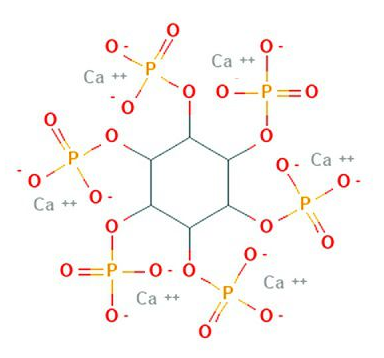In the past, there was little interest in the assessment of calcium (Ca) requirements in poultry diets. This was due to the availability of cheap limestone, which accounts for 80-85% of the total Ca in feed. However, driven by the numerous studies of the effect of Ca on phosphorus (P) digestibility and phytase efficacy, the impact of Ca on performance has gained increasing interest.
Research from recent years has indicated that oversupplying Ca can negatively affect animal performance:
- Limestone is a buffering substance and hinders sufficient acidification of the feed in the gizzard
- An excess of dietary limestone reduces feed intake
- Ca exerts a negative effect on the tight junctions, reducing gut integrity
- Excess Ca inhibits P digestibility of feeds
Inhibition of phytase on phytate degradation due to Ca
Dietary Ca forms complexes with phytate and these complexes can remain insoluble at a high pH (Figure 1).

These precipitated phytate-Ca complexes are not accessible for hydrolysis by a phytase and this reduces the amount of P released. Therefore, an excess of Ca will reduce the P digestibility. Moreover, the speed of the limestone solubilisation will dictate the concentration of Ca available to chelate with the phytate. Fine limestone is in general more soluble than coarse limestone, meaning it will bind faster to phytate. As a result, it has a stronger negative impact on P digestibility compared to a coarse limestone.
Ca and P need to be in balance
Lowering the Ca levels in feed would be advisable to improve P digestibility, besides the choice of a coarser limestone. However, absorbed P can only be retained in the bones when enough Ca is present at blood level to form hydroxyapatite (bone mineral). Lowering the Ca level will improve P digestibility, but due to the lack of Ca to retain the absorbed P, the P level in the bones can still be low. Deficiency of Ca can therefore cause poor bone quality, even when P digestibility is improved by lowering the Ca level. This indicates that an uncontrolled lowering of the Ca levels in the feed can also reduce the birds’ motility and thereby performance.
A broiler study
A practical example has been demonstrated in a recent 35-day broiler trial at the University of Warmia and Mazury, Poland.
Feed was reformulated with 1,000 FTU/kg of a novel intrinsic heat stable phytase (OptiPhos Plus), only using its corresponding P matrix value, while and NSPase complex (Hostazym X) was added on top. Two different Ca treatments were imposed:
- Normal Ca level: formulated at 8.5, 7.0 and 6.0 g/kg in the starter, grower and finisher diets, respectively
- Low Ca level: formulated at 6.5, 5.0 and 4.0 g/kg in the starter, grower and finisher diets, respectively
The overall technical performance was very good (EPEF > 500) showing the impact of the enzymes on securing a high broiler performance. Figure 2. Effect of lowering Ca levels on body weight and feed conversion at day 35
Figure 2. Effect of lowering Ca levels on body weight and feed conversion at day 35
The following effect of Ca could be noted:
- The low Ca level gave a significantly higher end weight vs when feeding normal Ca levels. Feed conversion was not impacted despite the higher bird weight at low Ca levels (Figure 2)
- Ca and P digestibility (at day 35) were highest at the low Ca inclusion level
- Bone ash analysis (at day 21) showed that tibia ash and Ca and P level in tibia ash were lower at the low Ca level. The impact was small, but significant (Table 1)
 Table 1. Ca and P digestibility, tibia ash content, and Ca and P content in tibia ash at normal and low Ca levels
Table 1. Ca and P digestibility, tibia ash content, and Ca and P content in tibia ash at normal and low Ca levels
The fact that low Ca levels optimised technical performance and improved P digestibility, but reduced bone ash, demonstrates that too low Ca levels will lead to too low Ca levels at blood level, and therefore result in inefficient bone formation. This also indicates that there is a higher Ca requirement for optimal bone growth compared to what is required to optimise performance.
Conclusion
- Reducing the Ca levels had a large positive impact, not only on animal performance, but also on Ca and P digestibility.
- Reducing Ca levels impacts the bone formation, showing that the Ca requirements for bone formation are higher compared to the Ca requirement for optimal animal performance.